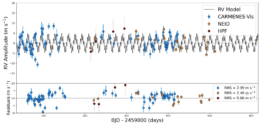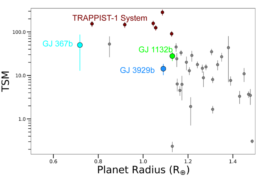Initial discovery is one thing, but true knowledge of a new exoplanet system requires careful follow-up studies. Sometimes, this extra effort simply refines what astronomers had already inferred; other times, it can turn up a surprise. In the best cases, such as a recent study focused on a planet circling GJ 3929, it can do both.
Suggestions of a Planet
It all started with the Transiting Exoplanet Survey Satellite (TESS), NASA’s latest planet-hunting lookout. Over its now four years in orbit, TESS has stared at millions of stars, checking each for signs of any attendant planets buzzing nearby. While TESS has been great at its job, it’s more of a scout for the exoplanet community than a detective: with so much sky to search, this busy satellite usually watches a star for only a few days at a time before moving on, alerting astronomers when it sees something suspicious but leaving the confirmation to others.
TESS phoned home to report on one of these candidate planets, GJ 3929b, in May of 2020. This one caught the eye of several teams long accustomed to scanning TESS reports: if this one was real, it was interesting. Although it was purportedly similar in size to Earth, it whipped around its tiny host star once every two days, making our languid year-long trip around the Sun seem lazy.
Earlier in 2022, another team published their analysis of GJ 3929b, which confirmed it was indeed an exo-Venus, and which hinted at a possible second, slightly farther out planetary companion. Recently, a team led by Corey Beard (University of California, Irvine) revealed their own exhaustive analysis, which went a step further and confirmed the second planet.
Many Methods

The best-fitting model of the radial velocity of GJ 3929, with data collected from multiple telescopes overplotted. The long-period component is from the newly confirmed planet c, while the faster sinusoid marks the influence of the inner planet b. [Beard et al. 2022]
The centerpiece of their analysis, however, turned on a particularly powerful new tool: the NEID (rhymes with “fluid,” from the Tohono O’odham word meaning “to see”) spectrometer at the Kitt Peak National Observatory. With a spectral resolution of R=110,000 and the ability to detect changes in the star’s motion down to 1.18 m/s, the team not only pinned down the mass of GJ 3929b, they also confirmed that GJ 3929c really was another planet circling a bit farther out on an a 15-day orbit.
A Special Planet

A scatterplot showing how amicable planets of different radii are to atmosphere characterization (Transmission Spectroscopy Metric (TSM)). GJ 3929b, the main focus of this work, is shown in blue: it is one of the most promising known small planets for future atmospheric studies. [Beard et al. 2022]
Citation
“GJ 3929: High-precision Photometric and Doppler Characterization of an Exo-Venus and Its Hot, Mini-Neptune-mass Companion,” Corey Beard et al 2022 ApJ 936 55. doi:10.3847/1538-4357/ac8480
